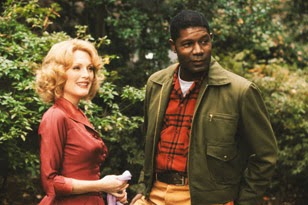Movie Review: The Fault in Our Stars
Director: Josh Boone
Reviewed: 27 June 2014
jamesintexas rating--***
The Fault in Our Stars shows the orbit of teen Hazel Grace Lancaster (Shailene Woodley), a Stage 4 thyroid cancer patient, who crosses paths in a church support group with the very direct Augustus Waters (Ansel Elgort), himself a survivor of osteosarcoma that has left him with a prosthetic right leg and a fearlessness exhibited by his central metaphor: a clenched unlit cigarette between his teeth. As he tells Hazel, "You put the killing thing right between your teeth, but you don't give it the power to do its killing." The two form a friendship that steadily grows as different health challenges threaten to keep them apart. The story holds its characters in such high regard that it moves beyond melodrama; all of the teens with cancer in this film are going to die and know that brutal fact. The urgency with which they act upon feelings connects with the limitations of the short amount of time they are given.
Because of its powerful story and memorable lines, it feels like it should be an automatic success. However, the fault with this movie lies in its execution. Josh Boone drowns out the sound during key dialogue scenes between Hazel and Augustus not understanding that part of the joy of understanding these characters and their burgeoning relationship involves their highly intelligent and literature back and forth. The danger of adapting a much-loved novel involves such risks. When does an adaptation get it right, and when does the visual set to music supplant the substantive conversation?
Ansel Elgort's grating, smarmy performance initially turns Augustus Waters into a grinning image of perfection and cleverness. He gets better as the film proceeds, and in later moments of vulnerability, the character seems most real and realized by Elgort. His work underscores how effective Shailene Woodley's work as Hazel is, and Boone is content to have his camera hold Woodley's face for thirty to forty-five seconds without cutting away. She holds the film's attention as Hazel, though it can be even a challenge for Woodley to make texting (or waiting for texts) compelling.
The Anne Frank House scene just struck me as tonally inappropriate. The decision to overlay the scene of Hazel climbing bravely with her oxygen tank with the reading of Anne Frank's words from her diary at first just seems heavy handed. This love story is about teens without much time, and reading
The Diary of Anne Frank is a haunting experience because we know that this is all the time Anne is ever given, that her crush on Peter remains unfulfilled, that her family was survived by only her father. The idea of lives cut short and the power of written words resonates here, especially given Hazel Grace's devotion to authors and books. But Boone turns the scene into a cathartic embrace between his leads, complete with swirling camera movement and spontaneous clapping from strangers at the roof of the Anne Frank House. Are we meant to equate The Holocaust with cancer? Are we meant to cheer for the romance here and in this moment? I found it more troubling and in poor taste.
A later scene that is supposed to be fun involving three teens and some eggs just left me feeling sad for the characters and the mom of one of the victims. The disposable soundtrack of treacly ballads telegraphs every emotion. The script's focus cuts away from the cancer group and its dynamics, the existence of Hazel and Augustus with their respective families, and the friendship with Isaac. In its hurry to pick up the pace and get to Hazel and Augustus, we lose the perspective of who these characters are. I admired the quiet strength in Laura Dern and Sam Trammell's performances as Hazel's parents who offer so much in so few scenes. They are not given much to do, which drains a climactic scene of some of its power, though I found the quiet moments between Hazel and each of her parents to be the most emotional and heart wrenching, perhaps because I have just become a parent myself.
The film has undeniable emotion from the powerful rendering in John Green's novel (Kenyon College, Class of 2000!). As a reader of this book first, I have to ask if the film adds to my understanding or appreciation of its characters and story. Ultimately, I do not think that director Josh Boone made choices to increase or deepen the complexity of one of the most beloved books of the last ten years. The missteps do not mar the story's cumulative power, but something has been lost in translation from book to screen. Shailene Woodley's performance, staring into oblivion, is worthy of consideration. And the story is a genuine tearjerker. I cried at least eight different times while watching
The Fault in Our Stars, and there is something incredibly moving about these characters and their short amount of time together.


















